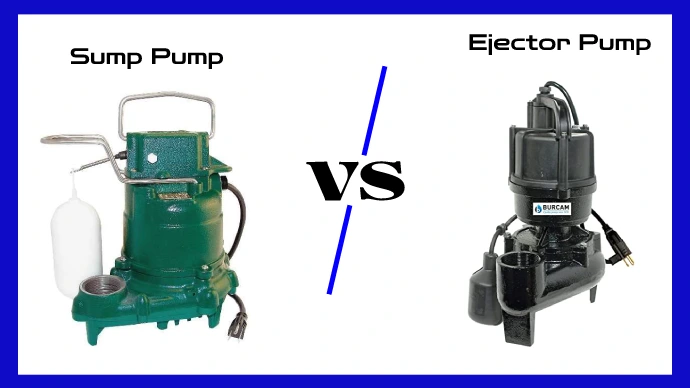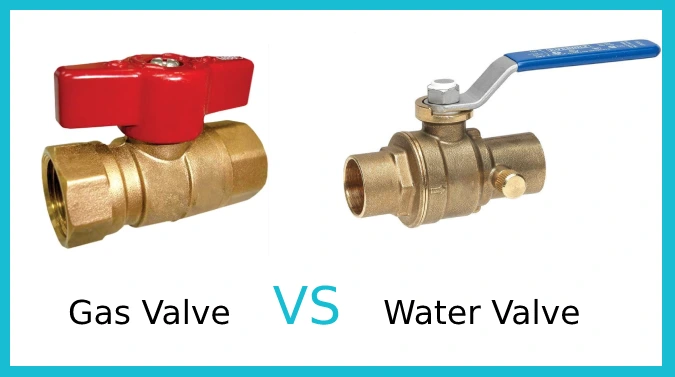Last Updated on May 16, 2023
Whether you’re dealing with a constantly-flooding basement or the occasional crawl space wetness, sump and ejector pumps are your go-to solutions.
Although they may seem similar in functionality, there are specific differences between the two that make one better suited for certain tasks.
Sump pumps are designed to remove accumulated groundwater in a sump basin or pit. Typically smaller in size with lower horsepower, sump pumps are straightforward to install and employ simpler plumbing connections.
In contrast, ejector pumps are more complex to install. They are designed to remove sewage and wastewater from a basement bathroom or laundry room, requiring plumbing connections and venting. Ejector pumps are typically louder due to their larger size and heavier-duty construction.
Ready to make an educated decision on what type of pump is ideal for your unique situation? Join us as we explore the key distinctions between sump and ejector pumps, giving you all the facts so that you can pick the perfect fit.
Sump Pump Vs Ejector Pump: Differences

Don’t let wet basements or crawl spaces be a drag. Both sump and ejector pumps are here to help. But it’s important to know which one is right for you. Let’s explore the distinction between sump and ejector pumps.
1. Purpose
Sump pumps are commonly used to remove excess groundwater that accumulates in a sump pit or basin. They are usually installed in the lowest part of a basement or crawl space to prevent water damage and flooding.
In contrast, ejector pumps get rid of sewage and wastewater from plumbing fixtures such as a basement bathroom, laundry room, or kitchen sink. While both pumps are essential for maintaining a dry basement, their purposes differ significantly.
2. Size
Sump pumps are generally smaller than ejector pumps, making them easier to install in tight spaces. However, these smaller pumps have lower horsepower ratings, which means they’re less powerful than ejector pumps.
Don’t let their size fool you, though. Sump pumps are designed to handle less volume and less pressure compared to ejector pumps, but they’re still efficient at what they do.
3. Capacity
Ejector pumps have a significantly higher capacity than sump pumps, making them ideal for handling sewage and wastewater that contains varying amounts of solids. Thanks to their powerful motor, ejector pumps can also pump out larger volumes of water faster than sump pumps.
Conversely, sump pumps are designed for handling smaller amounts of groundwater, making them a better choice for individuals dealing with minor flooding or water damage issues.
4. Construction
Ejector pumps are constructed with stronger and heavier-duty materials than sump pumps, as they need to be able to handle the abrasive nature of solid waste and wastewater.
In contrast, sump pumps are constructed of lighter-duty materials since they only deal with clean groundwater, which isn’t as corrosive as sewage or waste.
5. Discharge
Regarding the discharge process, there is also a difference between ejector pumps and sump pumps. Sump pumps are designed to pump water outside of the house or into a storm drain.
On the other hand, ejector pumps discharge wastewater into the sewer system. This is because ejector pumps are mainly used in basements, where it is required to pump up wastewater from the toilet, sink, shower, and washing machine to the main sewer line, which is located at a higher level.
6. Switch Types
Switch types vary between sump pumps and ejector pumps. Sump pumps come equipped with a float switch that turns the pump on and off based on the water level in the sump pit. This ensures that the pump only operates when it is necessary, thereby saving energy.
In our blog, we have already discussed the details of a sump pump switch. We were particularly impressed by the most affordable sump pump switch that deserves its spotlight. There we’ve broken down all of its features and benefits, so be sure to check it out.
This sump pump switch is an excellent choice for homeowners and commercial users. Its impressive power and sensitivity ensure that any sudden rise in water levels is detected immediately to activate the pump quickly. Thus, it provides reliable protection against costly damages while bringing its users peace of mind.
Ejector pumps can use either a float switch or a pressure sensor switch, depending on the type of ejector pump. Pressure sensor switches are ideal for ejector pumps that have a higher flow rate, while float switches are suitable for pumps with a lower flow rate.
7. Installation
The installation of sump pumps and ejector pumps is different from one another. Installing ejector pumps is more complicated since they require plumbing connections and venting.
This is because ejector pumps handle wastewater, which has solid waste materials and hence need to connect multiple pipes for smooth wastewater transportation.
Installing a sump pump, on the other hand, is much simpler, as it just requires digging a sump pit and placing the pump in it.
8. Noise Level
Noise levels also differ between sump and ejector pumps. Ejector pumps are generally louder than sump pumps because of their size and heavy-duty construction.
Their larger size is because they need to handle larger volumes of wastewater and transport it through larger pipes. Hence, they have to be built stronger to handle the pressure.
Sump pumps, on the other hand, do not have to handle solid waste materials and are designed for limited usage and tend to be smaller and quieter.
9. Electrical Requirements
Another difference between the two is their electrical requirements. Ejector pumps require a dedicated circuit and higher voltage than sump pumps.
Due to the fact that ejector pumps are responsible for pumping wastewater from below-grade plumbing fixtures, such as toilets and showers, a sump pump only needs to move water from the basement or crawl space.
The higher voltage requirement for ejector pumps ensures that it has the power necessary to move wastewater, whereas the lower voltage requirement for sump pumps means that it is able to operate on a standard household circuit.
10. Venting
Proper venting is essential for ejector pumps but not for sump pumps. This is because ejector pumps rely on gravity to move wastewater through a network of pipes and into the septic or sewer system.
As the wastewater flows downhill, it creates negative pressure, which can lead to the buildup of gasses. Without proper venting, these gasses can become trapped and cause damage to the plumbing or pose a health hazard to anyone in the home.
On the other hand, sump pumps do not require venting because they move water out of the basement using a motor and impeller. This means that there is no risk of negative pressure or gas buildup.
Can I Use an Ejector Pump As a Sump Pump?

While both ejector and sump pumps can pump water, it’s important to note that they serve different purposes. Therefore, they cannot be used interchangeably.
An ejector pump is designed to pump wastewater from basements or crawl spaces. It uses high pressure to move water and waste through piping into a sewage system.
On the other hand, a sump pump is designed to remove excess water and prevent flooding in areas such as basements.
It typically sits in a pit known as a sump basin and detects when water levels rise. Once detected, it pumps the excess water away from home through a discharge pipe.
While using a sewage ejector pump instead of a sump pump may be tempting, doing so could prove problematic. Ejector pumps are not designed to handle the constant water flow that a sump pump must handle.
Also, they do not have the same monitoring capabilities as a sump pump, making it difficult to detect rising water levels.
Can You Put Toilet Paper In a Sewer Ejector Pump?
Toilet paper should not be put in a sewer ejector pump. These pumps are specifically designed to handle wastewater and sewage, and they can quickly become overwhelmed by large amounts of solid materials like toilet paper.
When this happens, the pump can clog and break down, leading to expensive repairs and potential damage to the plumbing system.
Therefore, it is best to avoid putting toilet paper in sewer ejector pumps and instead dispose of it in a more appropriate way. By doing so, you can help ensure your plumbing system’s longevity and proper functioning.
How Long Do Basement Ejector Pumps Last?

Based on industry standards, sewage ejector pumps have a typical life span of 7 to 10 years, but many pumps have been known to last much longer.
However, it is not uncommon for problems to arise with the pump before it reaches the end of its expected life span. Factors that can affect the longevity of a basement sewage pump include frequency of use, the amount and type of waste being pumped, and maintenance practices.
Regular maintenance, such as inspecting and cleaning the pump components, can extend the pump’s life and prevent potential problems.
You must be aware of the signs of a failing ejector pump, such as unusual noises, foul odors, and slow drainage, to prevent potential water damage or sewage backups.
Water Damage Prevention: Choose Sump and Ejector Pumps
Determining which type of pump to use depends on your specific needs. If you need to remove only groundwater, then sump pumps are the best option.
But if you have a bathroom or laundry room in your basement that requires wastewater removal, ejector pumps are the right choice.
Both pumps offer excellent protection for your home by keeping it dry and free from water damage. Choose wisely to protect your property and enjoy a dry basement or crawl space.



